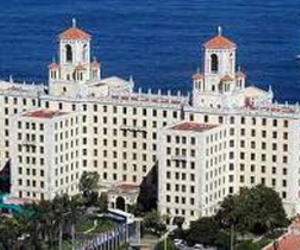Hotel’s story reads like parable of Havana’s history
- Submitted by: manso
- Travel and Tourism
- 01 / 09 / 2011

Nacional first drew movie stars and mobsters; now it’s tourists in flip-flops. By JENNY BARCHFIELD The Associated Press. Sat, Jan 8 - 4:54 AM. HAVANA, Cuba — The carpets are worn and the rooms have a musty feel. Yet Havana’s iconic Hotel Nacional, which marked its 80th birthday Dec. 29, wears its slightly shabby elegance with pride, an aging beauty a bit past its prime.
The hotel has welcomed movie stars and mobsters, but today’s visitors are mostly flip-flop-wearing tourists from Britain and Spain hoping to get a taste of the past at the apricot-coloured monolith on Havana’s seaside Malecon boulevard.
The hotel’s story reads like a parable of recent Cuban history, chronicling the island’s evolution from naughty tropical playground to communism’s Caribbean enclave.
"The strength of the hotel lies in its history, in everything it’s lived through and remained standing," said general manager Antonio Martinez Rodriguez. "Its fissures are like wrinkles on the face of an old and wise person who’s seen it all."
Opened in 1930 as a rum-soaked getaway for Mafia dons and Hollywood starlets, the Nacional became a training centre for illiterate peasant women after Fidel Castro’s 1959 revolution. It was shuttered around the time of the collapse of the Soviet Union, a major ally and protector, and was reborn following a major overhaul as a source of much-needed foreign currency.
The past has left its scars on the stone-and-concrete building, in the bullet holes that once pockmarked the facade — leftovers from a 1933 rebellion — and in the network of Cuban Missile Crisis-era tunnels and anti-aircraft positions still carved into the garden.
Its register reads like a Who’s Who of the 20th century. Luminaries such as Winston Churchill and Jean-Paul Sartre, Ernest Hemingway and Gabriel Garcia Marquez rubbed shoulders with mobsters including Lucky Luciano. Errol Flynn and Rita Hayworth slept under the same roof as Mickey Mantle and Fred Astaire.
Today, Steven Spielberg, Kate Moss, Javier Bardem and Sean Penn occasionally light the place up.
During the 1962 Cuban Missile Crisis, the five-star hotel served as a backdrop for some of the brinksmanship that brought the world close to nuclear war. As the standoff neared the boiling point, Cuban soldiers dug a web of invisible tunnels beneath the verdant lawns and installed three Soviet anti-aircraft guns.
The Nacional was also the scene of a bombing by an anti-Castro group in July 1997.
Plans for the hotel were hatched in the late 1920s under president Gerardo Machado. Though the Cuban government ostensibly was responsible for the lion’s share of the $7-million investment, general manager Martinez said much of the impetus for the project came from the mob, which was flush with Prohibition-era cash.
Marketed as a tropical paradise, the casino and cabaret delivered no-holds-barred fun to the Nacional’s then-largely American clientele, and the Mafia pocketed the profits, Martinez said.
In December 1946, about 500 Mafiosos descended on the hotel for a mob summit — an event immortalized in fictional form in The Godfather Part II. During the six-day-long gathering, the dons divided up the spoils of Cuba’s lucrative gambling, drug and prostitution rackets, said the hotel’s resident historian, Estela Rivas. Rivas sometimes serves as tour guide, making one of her stops the second-floor suite where Lucky Luciano and Meyer Lansky held their talks.
She also brings visitors to the hotel’s cabaret — where showgirls in marabou feathers and strategically placed sequins continue to enthral — and the Churchill Bar, where Britain’s wartime prime minister liked to relax with a Romeo y Julieta cigar during his stay in 1946.
The Nacional’s decades of high-wattage glamour and anything-goes decadence came to an abrupt end in 1959 with the triumph of Castro’s revolution.
The hotel was nationalized, its walls hung with pro-communist banners. Hundreds of rural women learned to read and sew there.
In 1990, the hotel closed for a total renovation, Martinez said, reopening two years later.
Nowadays, 86,000 tourists pass through the Nacional’s 426 rooms each year, Martinez said. With standard rooms priced at the modest rate of 120 convertible pesos (about US$129) per night, the hotel attracts mostly middle-class Europeans.
Source: http://thechronicleherald.ca/Travel/1220832.html
Comments